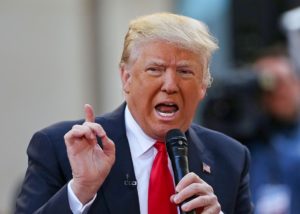May 26, 2018

In his speeches on the Iranian nuclear deal, President Trump is demonstrating that he doesn’t know very much about it.
At an April 30 press conference and in other appearances, Trump said, “In seven years that deal will have expired, and Iran is free to go ahead and create nuclear weapons. That’s not acceptable. Seven years is tomorrow. That’s not acceptable.”
Not only is it unacceptable, it is also not true.
What expires in another eight years, in January 2026, is not the nuclear agreement, but some sections of the nuclear agreement—specifically the section limiting Iran to no more than 5,060 centrifuges and the section restricting what work it can do to develop better centrifuges than the 1950s technology it is now using.
The nuclear agreement that took effect in January 2016 imposes a number of restrictions on Iran’s nuclear program. Some of them come off after 10 or 15 years, others after 20 or 25, which is 2041. Others never come off. For example, the provision giving inspectors from the International Atomic Energy Agency (IAEA) access to Iran’s nuclear program around the clock never comes off.
Trump said Iran could build a nuclear weapon after another seven years. But after another eight years, Iran will only be able to enrich uranium to 3.67 percent, while enrichment to around 90 percent is needed for nuclear weapons. That limit will not come off until 2031.
“By far the most important and the most difficult step is producing the fuel,” said Matthew Kroenig at Georgetown University’s School of Foreign Service. “That’s why the Obama Administration wanted to limit Iran’s capacity to enrich uranium. And it’s why it was so important to Iran to have the limits end after 15 years [in 2031].”
Under the deal, Iran gave up 14,000 of its 19,000 centrifuges, the machines used to enrich uranium, and it agreed to only enrich uranium to 3.67 percent and to give up 97 percent of its stockpile of enriched uranium. The cap on centrifuges comes off after 10 years and the other two restrictions after 15 years.
Continuous surveillance of sites where centrifuges are made comes off after 20 years and continuous surveillance of uranium mines and mills comes off after 25 years.
For plutonium, the other possible fuel for a nuclear bomb, the agreement bans plutonium reactors for 15 years and stipulates that Iran must dismantle its current one, which it has done.
For those concerned about an Iranian nuclear weapons program, the key year then is 2031, still 13 years away.
Trump has said that in seven years Iran would be free to build nuclear weapons. But under the Obama agreement with Iran as well as under and the nuclear Nonproliferation Treaty that Iran signed years ago, Iran agreed never to build a nuclear weapon.
“Some of the terms last forever,” said nuclear arms expert Matthew Bunn at Harvard’s Kennedy School. “The deal prohibits Iran forever from the key activities of a nuclear weapon design and manufacture program — experimenting with the relevant types of explosives, doing the relevant neutron modeling, and so on.”
Bunn added: “And Iran’s acceptance of the broader inspections called for in the International Atomic Energy Agency’s Additional Protocol also lasts indefinitely.”
The nuclear deal is far from perfect and there are many provisions that can readily be criticized, such as the various numerical caps that come off. But it’s not as weak as what Trump says it is.